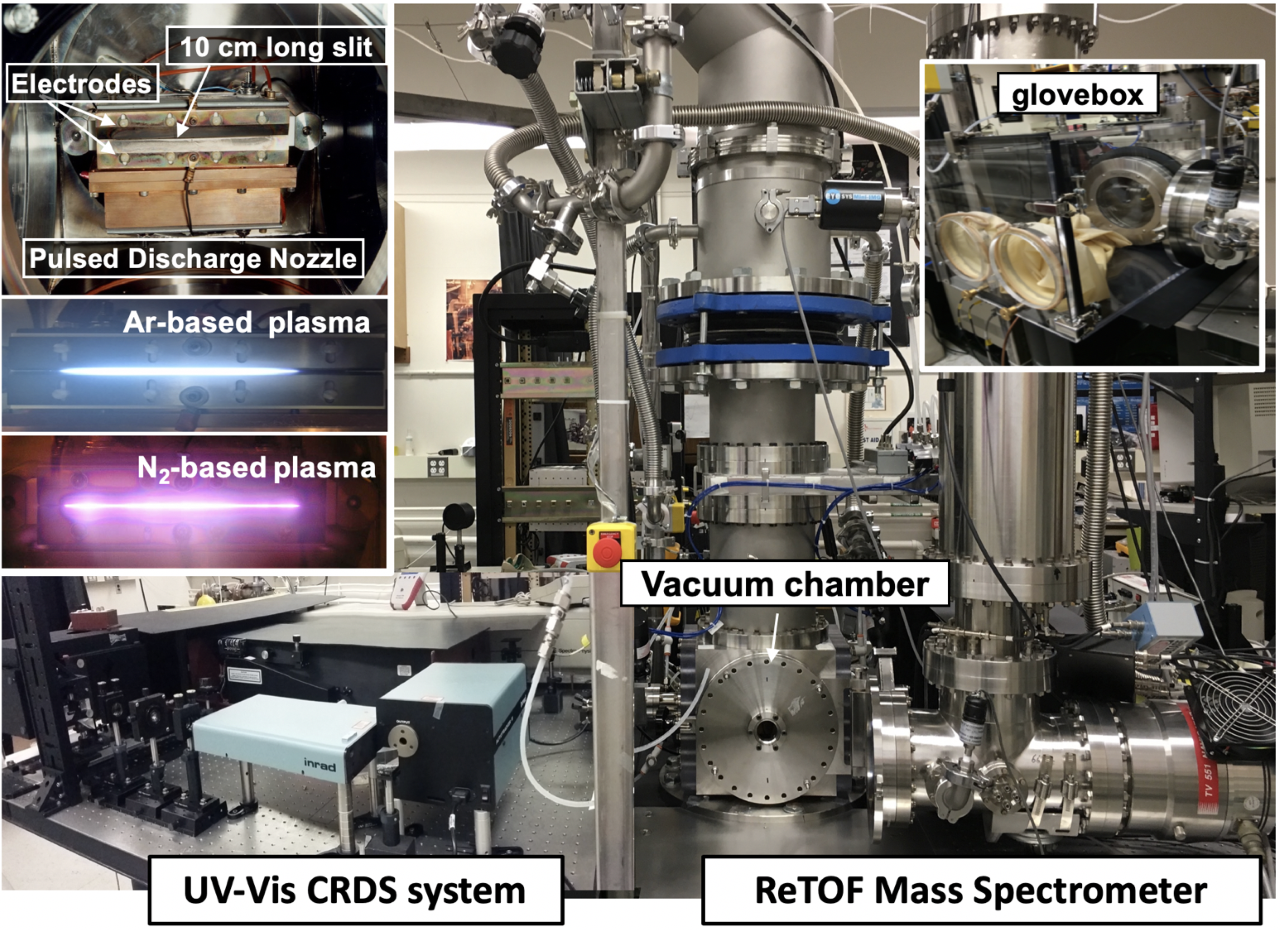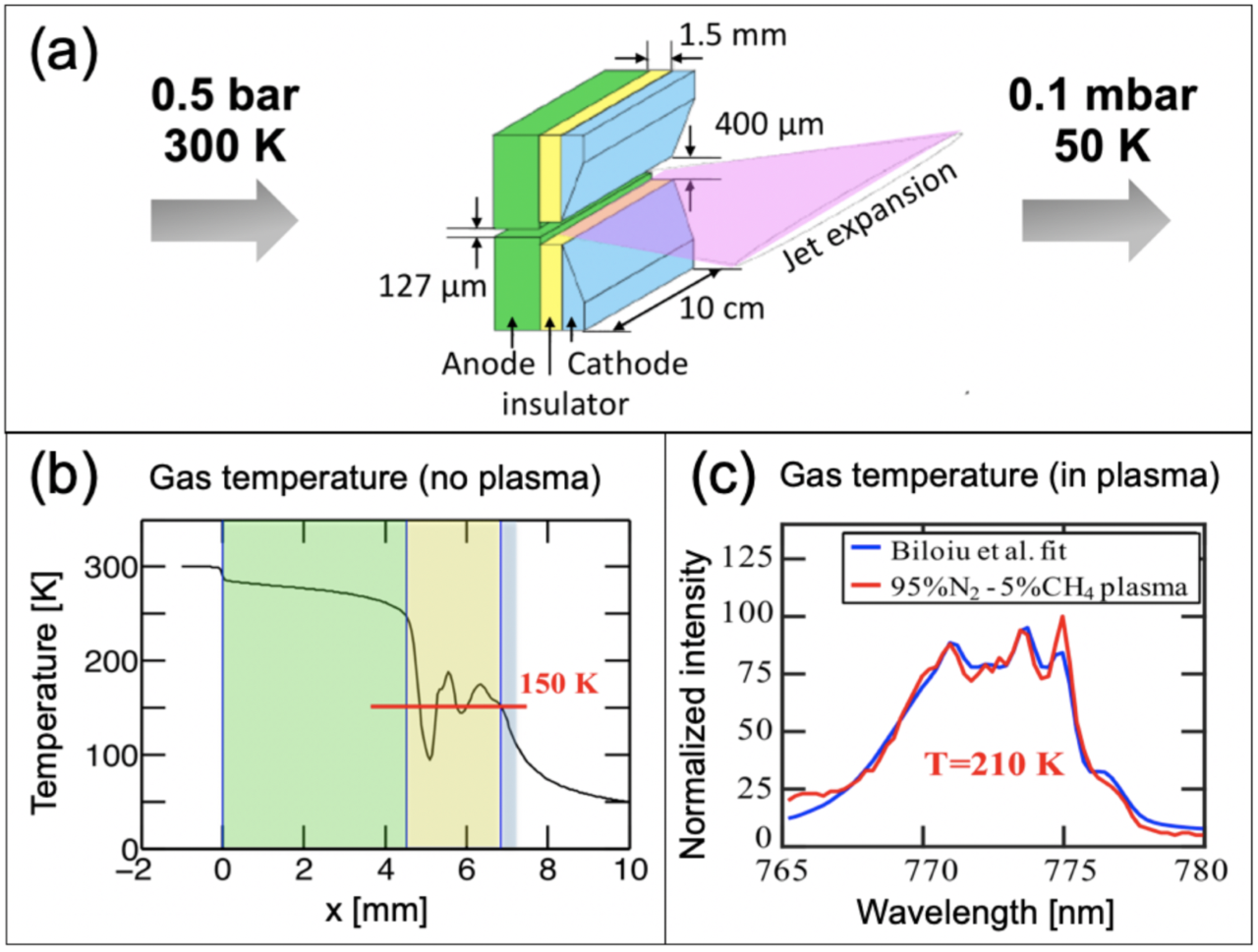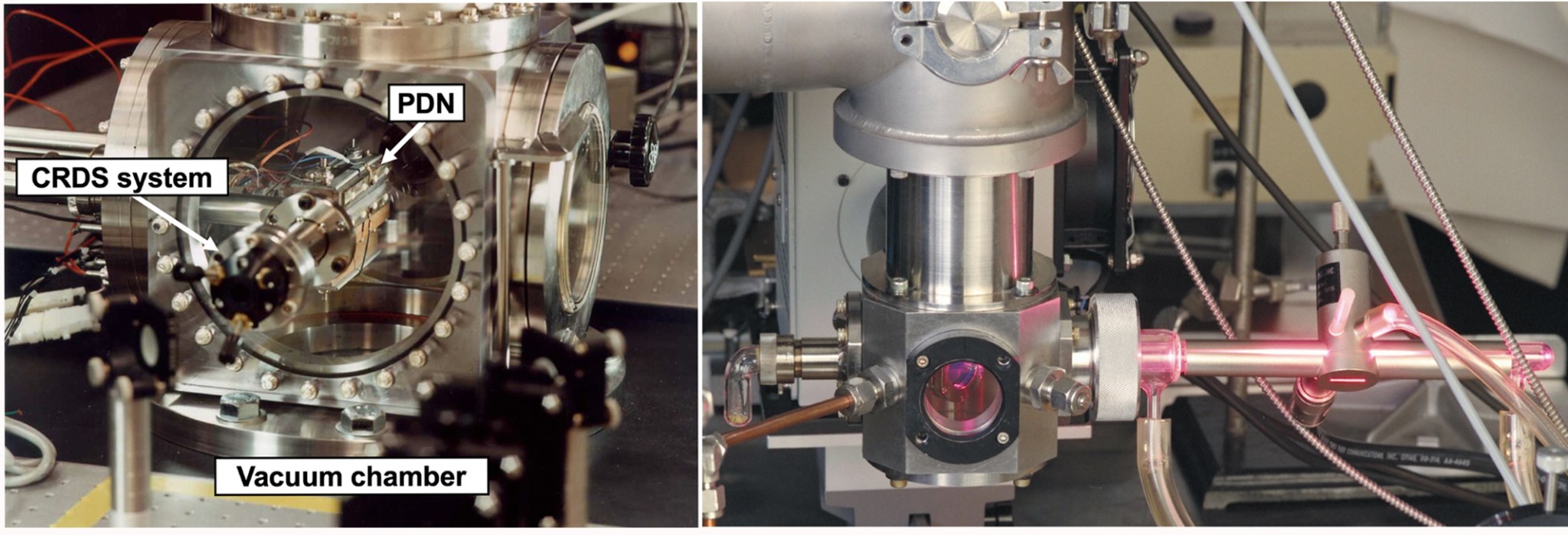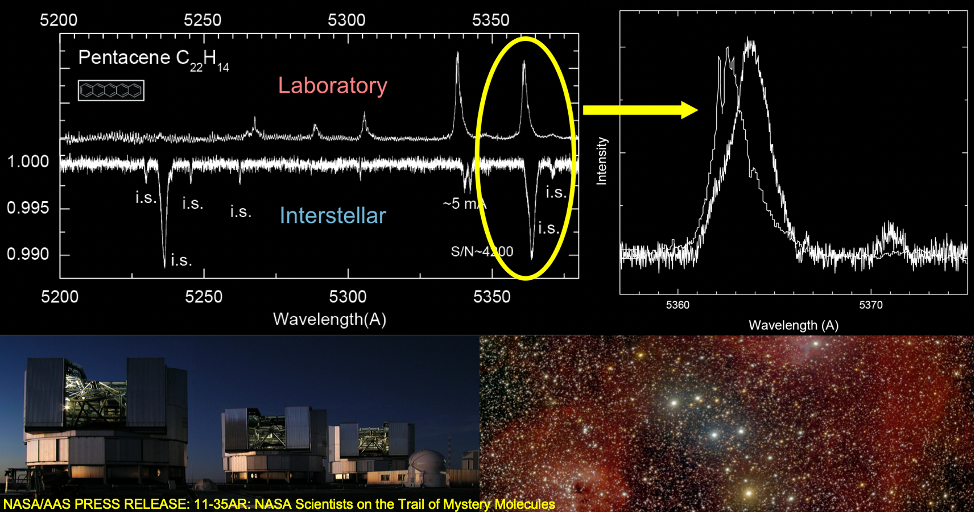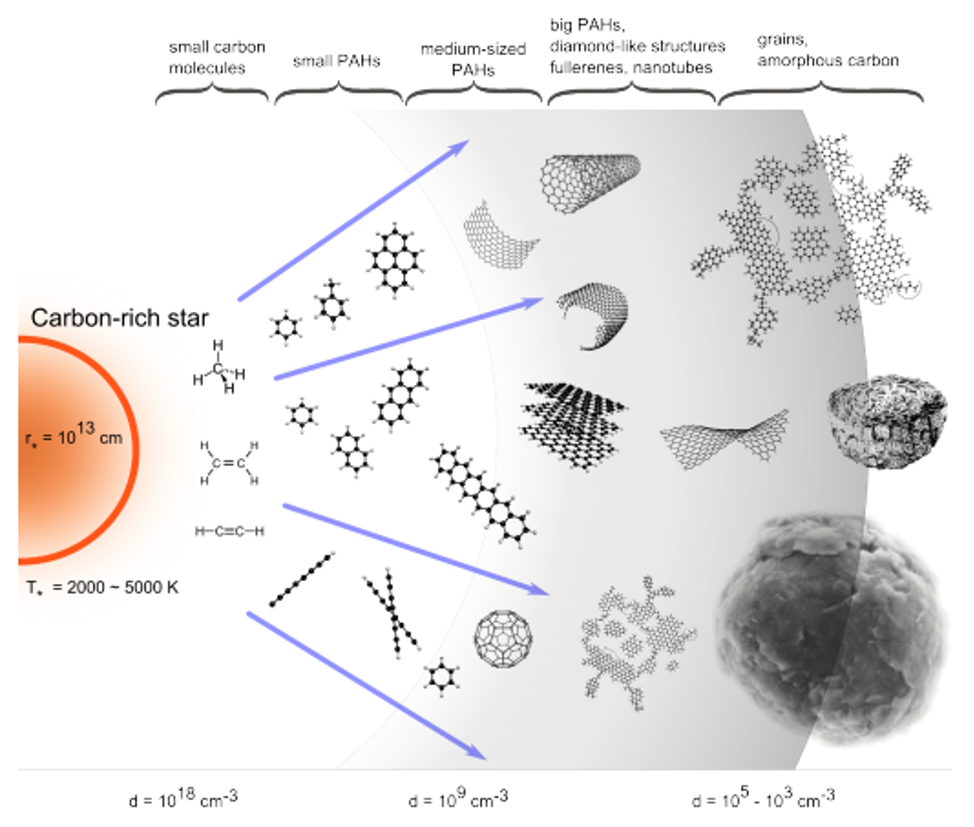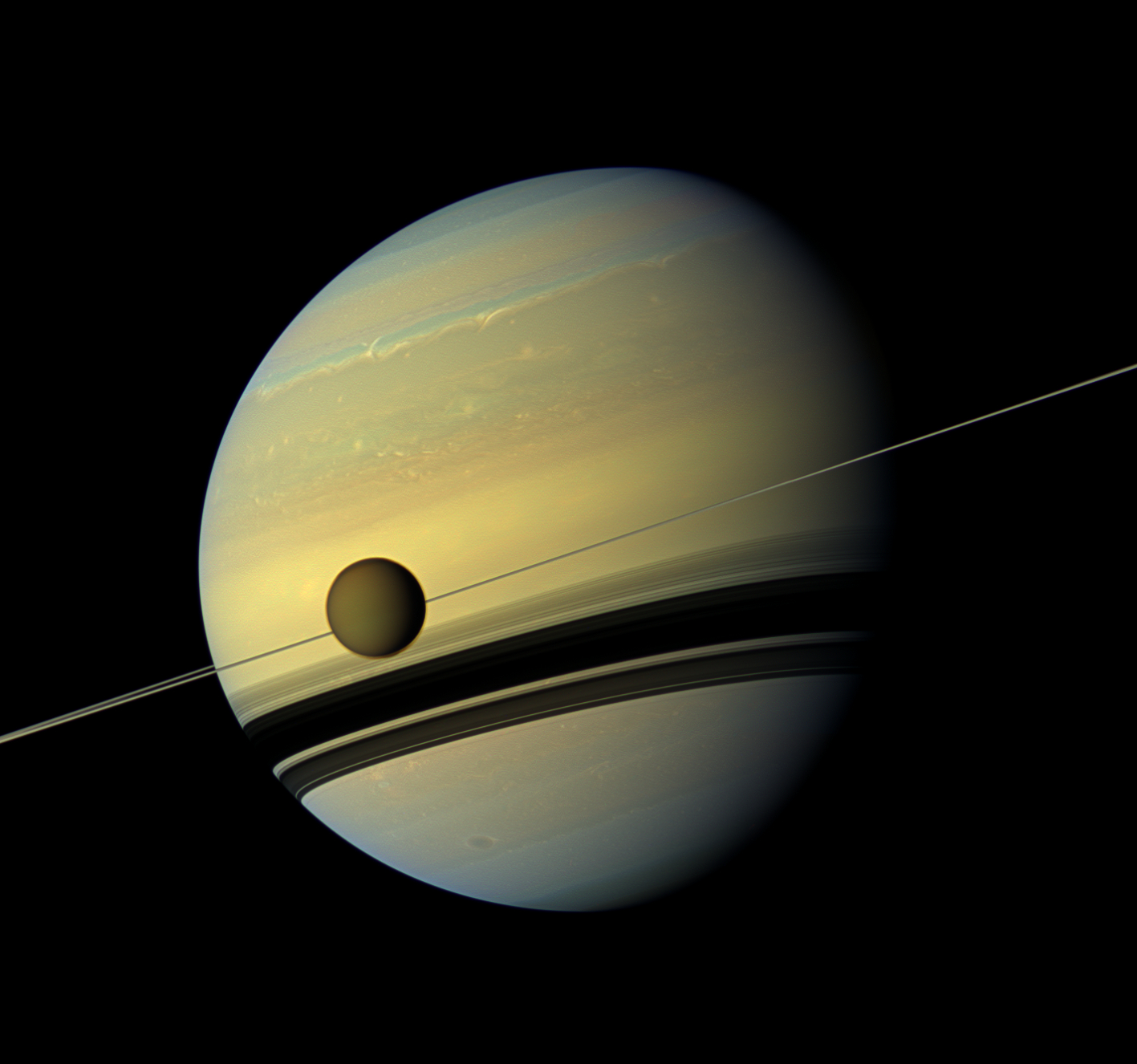COSmIC Facility
Members: Farid Salama, Ella Sciamma-O’Brien, Salma Bejaoui, Lisseth Gavilan, David Dubois
COSmIC stands for “Cosmic Simulation Chamber” and was developed to generate interstellar, circumstellar, planetary analogs in the laboratory.
COSmIC is dedicated to the study of neutral and ionized molecules and nanoparticles and grains under the temperature and vacuum conditions that are required to simulate space environments. (Salama et al. 2017).
Objectives: generate, process, and analyze cosmic analogs in the laboratory
1. Interstellar Environments (gas phase: UV-Vis-IR CRDS)
2. Circumstellar Outflows (gas phase: ReTOF-MS, solid phase: cosmic grain analogs)
3. Planetary Environments (gas phase: ReTOF-MS, solid phase: aerosol analogs)
Equipment:
The COsmic SImulation Chamber (COSmIC) (cf. Figures 1-3)
- Vacuum chamber equipped with Pulsed Discharge Nozzle (PDN) to produce a free supersonic jet-cooled plasma expansion (50–150 K, 0.1–30 mbar, 1-2 eV energy in plasma)
- Laser Cavity Ring Down Spectroscopy (CRDS) system (UV-Vis: 0.3–0.8 µm, NIR-MIR: 2.7-4 µm)
- Reflectron Time-Of-Flight Mass Spectrometer (reTOF-MS) (for the detection of positive and negative ions and neutral molecules, 5-3000 m/z)
- A modular Glove box for collecting samples under controlled (argon) atmosphere
Matrix isolation Spectroscopy (MIS) chamber configured for absorption spectroscopy (cf. Figure 4)
- Cryovacuum system (6 K, 10-8 Torr)
- VUV lamp (110-180 nm)
- UV-Vis spectrometer (200-1000 nm)
Matrix isolation chamber (MIS) configured for Laser-Induced Fluorescence (LIF) (Figure 4)
- Cryovacuum system (10 K)
- NUV-VIS-NIR Emission spectrometer (200–1000 nm)
Matrix isolation chamber (MIS) equipped with a Fluorescence Lifetime Excitation-Emission Spectrometer (FLEXEMS – SBIR)
- Detection of trace organics (10–100 ppb)
- Emission: 250–700 nm
Objectives: To generate, process, and analyze interstellar, circumstellar, and planetary analogs produced at low temperature in the laboratory
Methodology: COSmIC uses a supersonic jet expansion (see schematic a) in Figure 2) to cool gas mixtures down to astrophysically-relevant temperatures (b) before inducing chemistry using a plasma discharge. The temperature remains low in the plasma discharge (c).
Applications: Interpretation of observational data by NASA missions by
- directly comparing experimental data to observations
- providing experimental data to modelers and quantum chemists
- understanding production mechanisms and chemical pathways
(cf. press release here)
Objective 1. Simulating Interstellar Environments (UV-Vis-IR CRDS)
Missions supported: HST, JWST, SOFIA
Applications:
- interstellar clouds in galactic and extra galactic environments
- unidentified bands in astronomical spectra
Absorption Spectroscopy: in COSmIC, PAH molecules can be seeded in a cold argon free jet expansion and then softly ionized by a plasma discharge. Absorption spectra of neutral and ionized PAH molecules can be measured using cavity ring-down spectroscopy (CRSD) (Bejaoui & Salama, 2019) and then directly compared to observational data (Salama et al. 2011).
Example: First astronomical survey for the detection of PAHs in absorption
Emission Spectroscopy: Laser-Induced Fluorescence spectra (LIF) of neutral PAHs measured in 10 K inert-gas matrices were investigated and compared with the luminescence spectra measured in the Red Rectangle (RR) Nebula, a protoplanetary nebula that is one of the brightest sources of extended red emission and of UIR band emissions. These measurements indicate that small neutral PAHs can contribute to the blue fluorescence observed in the RR (Bejaoui et al. 2015).
Objective 2. Simulating Circumstellar Outflows (TOF-MS/grains)
Missions supported: HST, JWST, SOFIA, Stardust
Applications: circumstellar outflows, interstellar extinction, meteorites, comets
Gas Phase Analysis: In COSmIC, simple hydrocarbons (CH4, C2H2, …) and PAHs seeded in argon (Ar) gas can be used as precursors to study grain formation in the gas phase. These Ar-based mixtures are injected in the Pulsed Discharge Nozzle, generating a supersonically-cooled plasma discharge, and producing more complex molecular species that can then be extracted and directly detected by Reflectron Time of Flight Mass Spectrometry.
Example: Formation of carbon dust grains in circumstellar outflows of late carbon stars (Contreras & Salama 2013)
Solid Phase Analysis: In COSmIC, solid nm-to-µm-size particles form in the plasma discharge resulting from complex chemistry occurring between the molecular gas precursors in the Ar-hydrocarbon expansion. These cosmic grain analogs can be deposited onto different substrates for further ex situ analyses like Scanning Electron Microscopy (SEM), infrared (IR) spectroscopy, XANES spectroscopy, SIMS, etc.
Example: The COSmIC facility can be used to produce carbonaceous grains analogs of cosmic grains that would be formed at low temperatures in the condensation zone of circumstellar envelopes. A first study investigated the formation of grains from small gas-phase hydrocarbon molecules (press release). Recently, the COSmIC experimental setup was also used to produce cosmic dust analogs at low temperatures from gas-phase benzene and polycyclic aromatic hydrocarbons (Gavilan Marin et al. 2020).
Objective 3. Simulating Planetary Environments (TOF/aerosols)
Missions supported: Cassini, New Horizons, JWST, WFIRST, Clipper
Applications:
- hazes (Titan, Pluto, exoplanets) and
- plumes (Europa…)
Simulation of atmospheric chemistry at low temperature:
COSmIC can be used to cool down a gas mixture representative of planetary atmospheres in the supersonic expansion of the PDN before inducing the chemistry by pulsed plasma. The gas remains at low temperature in the plasma discharge (~200 K). The use of a pulsed plasma expansion results in a truncated chemistry. Different gas mixtures can be injected in the plasma, with or without the addition of heavier precursors in order to monitor the evolution of the chemical growth, from molecular reactions to the formation of aerosols. Both the gas- and solid phase products resulting from the plasma-induced chemistry can be analyzed.
Example: The Titan Haze Simulation (THS) experiment on COSmIC – Simulating Titan’s atmospheric chemistry at low temperature
Gas Phase Analysis: Nitrogen-CH4 based mixtures were used to study the first time, the first and intermediate steps of Titan’s chemistry and the early stages of aerosol formation, at Titan-like temperature (150 K) with the THS. (Sciamma-O’Brien et al. 2014, Raymond et al. 2018)
Solid Phase: A scanning Electron microscopy study and an IR spectroscopy of the grains produced in N2-CH4 plasmas, analogs of Titan’s aerosols showed the effect of the initial gas mixture on the morphology and composition of the grains. Comparison to Cassini’s observational data showed that, in COSmIC, simpler mixtures produce aerosols that are more representative (more N- incorporation) of Titan aerosols. (Sciamma-O’Brien et al. 2017).
Find our publications here.

























